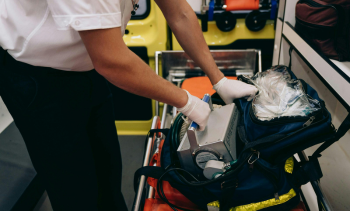Recognizing and Managing Heat Stroke in the Field: A Guide for EMTs
Understanding Heat Stroke
Heat stroke is the most severe form of heat-related illness and a true medical emergency. It occurs when the body’s thermoregulation system fails, leading to a core temperature above 104°F (40°C). Without rapid recognition and treatment, it can result in organ failure, neurological damage, or death.
Heat stroke typically falls into two categories:
- Classic (non-exertional) heat stroke – usually affects vulnerable populations such as the elderly, infants, or those with chronic illnesses during prolonged exposure to high environmental temperatures.
- Exertional heat stroke (EHS) – commonly occurs in young, healthy individuals during intense physical activity in hot or humid environments, such as athletes, construction workers, or military personnel.
Recognizing the Signs and Symptoms
Early recognition is vital for field providers. EMTs should assess environmental conditions, patient history, and physical presentation.
Key indicators of heat stroke include:
- Core body temperature ≥ 104°F (40°C)
- Altered mental status (confusion, agitation, seizures, or unconsciousness)
- Hot, dry skin (though sweating may still be present in exertional cases)
- Tachycardia and hypotension
- Rapid, shallow respirations
- Headache, dizziness, or nausea
- Lack of coordination or collapse
Differentiating from heat exhaustion: Patients with heat exhaustion are typically still sweating and alert, with body temperatures below 104°F. Once mental status changes occur, the condition should be treated as heat stroke until proven otherwise.
EMT Field Treatment and Management
Immediate and aggressive cooling is the cornerstone of treatment. EMTs play a critical role in preventing further thermal injury before arrival at the hospital.
1. Ensure Scene Safety and Begin Assessment
- Move the patient to a cool, shaded, or air-conditioned area.
- Remove excessive clothing and gear.
- Perform a rapid primary assessment, focusing on airway, breathing, and circulation (ABCs).
2. Rapid Cooling Methods
The goal is to lower core temperature to below 102°F (38.9°C) as quickly as possible.
Field cooling interventions may include:
- Cold-water immersion (best method when feasible): Immerse the patient in cold water (35–59°F / 1.6–15°C) if available.
- Evaporative cooling: Spray tepid water while fanning air over the patient.
- Ice packs: Apply to major vascular areas (neck, armpits, groin).
- Cool IV fluids (if within protocol).
Avoid shivering, as it increases body heat—if shivering occurs, reduce cooling intensity temporarily.
3. Airway and Circulation Support
- Administer high-flow oxygen as needed.
- Monitor ECG for arrhythmias caused by electrolyte imbalance.
- Establish IV access for fluid resuscitation—use isotonic crystalloids like normal saline to treat dehydration and support perfusion.
- Avoid overhydration; goal is to maintain adequate perfusion without fluid overload.
4. Monitor and Transport
- Continuously monitor temperature, cardiac rhythm, and mental status.
- Transport to the nearest facility capable of advanced care, ideally one with the ability for continued cooling and management of complications (renal failure, rhabdomyolysis, DIC).
- Document environmental conditions, time of onset, interventions, and temperature readings.
Post-Incident Considerations
Following treatment, patients who have suffered from heat stroke require careful follow-up, as complications such as renal injury, hepatic failure, and coagulopathies can develop hours later.
EMTs should also rehydrate themselves and monitor for signs of heat stress—especially after prolonged exposure or strenuous field operations.
Key Takeaways for EMTs
- Heat stroke is a life-threatening emergency requiring rapid recognition and aggressive cooling.
- A core temperature ≥104°F with altered mental status is diagnostic.
- Cold-water immersion is the gold standard for cooling; if unavailable, use evaporative and ice-pack methods.
- Monitor ABCs, provide supportive care, and transport rapidly for definitive management.
Continue Your Education in Emergency Care
Staying current on emergency medical response and field treatment protocols is essential for every EMT. Pedagogy Continuing Nurse Education offers online, self-paced continuing education courses designed to keep first responders up to date on life-saving field practices, patient safety, and clinical competence.
Explore our Emergency and First Responder Continuing Education Courses at:
👉 Pedagogy Education
References
- Centers for Disease Control and Prevention (CDC). Heat-Related Illnesses: Heat Stroke. Updated 2024. https://www.cdc.gov/disasters/extremeheat/heat_guide.html
- American College of Emergency Physicians (ACEP). Clinical Policy: Critical Issues in the Evaluation and Management of Emergency Department Patients with Heat-Related Illness. Ann Emerg Med. 2020;76(4):e1-e13.
- National Association of EMS Physicians (NAEMSP). Prehospital Cooling Techniques for Exertional Heat Stroke: Position Statement. Prehospital Emergency Care. 2021;25(5):707–710.
- American Heart Association. First Aid Guidelines for Heat-Related Emergencies. Circulation. 2020;142(16_suppl_2):S531–S543.
- Casa DJ, et al. National Athletic Trainers’ Association Position Statement: Exertional Heat Illnesses. J Athl Train. 2015;50(9):986–1000.

